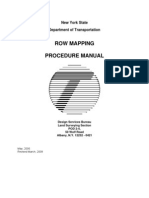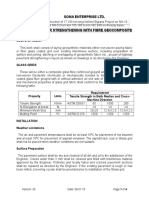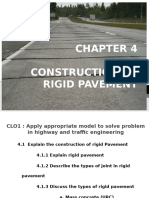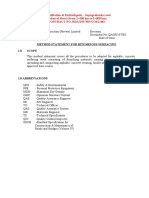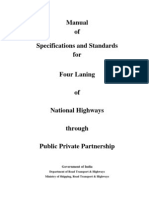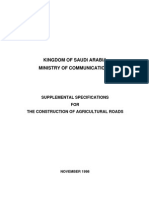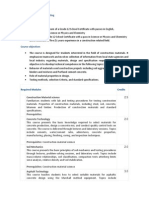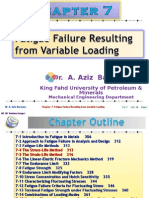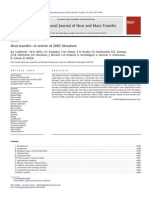Module 9 Asphalt
Uploaded by
Minari ChaengModule 9 Asphalt
Uploaded by
Minari ChaengCE 106 Construction Materials and Testing Module No.
c CHAPTER 9
ASPHALT
OVERVIEW
Asphalt is one of the oldest materials in construction. Asphalt binders were used in 3000 B.C., preceding
the use of the wheel by 1000yrs. Before the mid 1850s asphalt came from natural pools found in various
locations throughout the world, such as the Trinidad Lake asphalt that is still mined. However, with the
discovery and refining of petroleum in Pennsylvania, use of asphalt cement became wide-spread. By
1907, more asphalt cement came from refineries than came from natural deposits. Today practically
all asphalt cement is from refined petroleum.
OBJECTIVES
At the end of this module, you will be able to;
1. Learn the usual production of Asphalt and Tars
2. Know different types of Asphalt products
3. Understand the Classification of Asphalt.
4. Learn about Asphalt Concrete and its mix design methods
5. Know some Classifications of Asphalt Concrete.
6. Classify the common additives being used in Asphalt concrete mix design
DEFINITION
Bituminous materials are classified as asphalts and tars as shown in figure below. Several asphalt
products are used; asphalt is used mostly in pavement construction, but is used as sealing and
waterproofing agents, as well. Tars are produced by the destructive distillation of bituminous coal or
by cracking petroleum vapors. Tar may also be used for pavement treatments, particularly where fuel
spills may dissolve asphalt cement, such as on airport aprons.
PANGASINAN STATE UNIVERSITY 1
CE 106 Construction Materials and Testing Module No. 9
The fractional distillation process of crude petroleum is illustrated in figure below. Different products
are separated at different temperatures. It shows the main products such as gasoline, kerosene, diesel
oil, and asphalt residue (asphalt cement).
PANGASINAN STATE UNIVERSITY 2
CE 106 Construction Materials and Testing Module No. 9
TYPES OF ASPHALT PRODUCTS
Asphalt used in pavements is produces in three forms: asphalt cement, asphalt cutback, and asphalt
emulsion. Asphalt cement is a blend of hydrocarbons of different molecular weighs. At room
temperatures, asphalt cement is a semisolid material that can be applied readily as a binder without
heating it. Liquid asphalt products, cutbacks and emulsions have been developed and can be used
without heating.
Although the liquid asphalts are convenient, they cannot produce a quality of asphalt
concrete comparable to what can be produced by heating neat asphalt cement and mixing with
carefully selected aggregates. Asphalt cement has excellent adhesive characteristic, which make it
a superior binder for pavement applications. In fact, it is the most common binder material used in
pavements.
A cutback is produced by dissolving asphalt cement in lighter molecular weight hydrocarbon
solvent. When the cutback is sprayed on a pavement or mixed with aggregates, the solvent
evaporates, leaving the asphalt residue as the binder. In the past, cutbacks were widely used in
highway construction. However, three disadvantages have severely limited the use of cutbacks. First,
as petroleum costs have escalated, the use of the expensive solvents as a carrying agent for the
asphalt cement is no longer cost effective. Second, cutbacks are hazardous materials due to the
volatility of the solvents. Lastly, application of cutback releases environmentally unacceptable
hydrocarbons into the atmosphere.
An alternative to dissolving the asphalt in a solvent is dispersing the asphalt in water as
emulsion. The asphalt cement is physically broken down into micron-sized globules that are mixed into
water containing an emulsifying agent. Emulsified asphalts typically consist of about 60% to 70%
asphalt residue, 30% to 40% water and a fraction of a percent of emulsifying agent.
USES OF ASPHALT
The main use of asphalt is in pavement construction and maintenance. In addition, asphalt is used in
sealing and waterproofing various structural components, such as roofs and underground
foundations.
PANGASINAN STATE UNIVERSITY 3
CE 106 Construction Materials and Testing Module No. 9
Superpave
In 1987, the strategic highway research program (SHRP) began developing a new system for
specifying asphalt materials and deigning asphalt mixes. The final product of the SHRP is a new system
referred to as Superpave (Superior Performing Asphalt Pavements). The objectives of this research
were to extend the life or reduce the life-cycle costs of asphalt pavements, to reduce maintenance
costs, and to minimize premature failures. Note that the Superpave specifications use the term asphalt
binder, which refers to the asphalt cement with or without the addition of modifiers.
CLASSIFICATION OF ASPHALT
Several methods are used to characterize asphalt binders, asphalt cutbacks, and asphalt emulsions.
Asphalt Binders
Asphalt binder is produced in several grades or classes. There are four methods for classifying asphalt
binders:
1. Performance grading (Superpave)
2. Penetration grading
3. Viscosity grading
4. Viscosity of aged residue grading
Superpave Binder Specifications and Selection. Several grades of binder are available based on
their performance in the field. Names of grade start with PG (Performance Graded) followed by two
numbers representing the maximum and minimum pavement design temperatures in Celsius,
Other Asphalt Binder Grading Methods. Table below shows various asphalt cement grades based
on penetration and on their properties. The grades correspond to the allowable penetration range,
that is, the penetration of a 40-50 grade must be in the range of 40-50.
PANGASINAN STATE UNIVERSITY 4
CE 106 Construction Materials and Testing Module No. 9
Various grades based on viscosity and their properties are shown in table below. High viscosity asphalt
cements have a high designation number.
Asphalt Cutbacks
Three types of cutbacks are produced, depending on the hardiness of the residue and the type of
solvent used. Rapid-curing cutbacks are produced by dissolving hard residue in a highly volatile
solvent, such as gasoline. Medium-curing cutbacks use medium hardness residue and a less volatile
solvent, such as kerosene. Slow-curing cutbacks are produced by either diluting soft residue in
nonvolatile or low-volatile fuel oil or by simply stopping the refining process before all of the fuel oil is
removed from the stock.
Asphalt Emulsions
Asphalt emulsions can be ither anionic or cationic, depending on the electric charge. Also, emulsions
set (break) at different rates. Three types of emulsion are produced: rapid setting (RS), medium-setting
(MS), and slow-setting (SS). Rapid setting emulsion sets in about 5-10minutes, medium setting in several
hours and slow-setting in a few months.
Other emulsion types are also produced, such as the high float residue emulsion and the quick
set emulsion. Different types and grades of emulsions are used for different pavement applications.
ASPHALT CONCRETE
Asphalt concrete, also known as hot mix asphalt (HMA), consists of asphalt cement, and aggregates
mixed together at a high temperature and placed and compacted on the road while still hot. The
performance of asphalt pavements is largely a function of the asphalt concrete surface material.
Desired Properties
The objective of the asphalt concrete mix design process is to provide:
1. Stability or resistance to permanent deformation under action of traffic loads, especially at
high temperature.
2. Fatigue resistance to prevent fatigue cracking under repeated loadings.
3. Resistance to thermal cracking that might occur due to contraction at low temperatures.
4. Resistance to hardening or aging during production in the mixing plant and in service.
5. Resistance to moisture induced damage that might result in stripping of asphalt from
aggregate particles;
6. Skid resistance by providing enough texture at the pavement surface.
7. Workability to reduce the effort needed during mixing, placing and compaction.
PANGASINAN STATE UNIVERSITY 5
CE 106 Construction Materials and Testing Module No. 9
Asphalt concrete is produced in either a batch plant or a continuous (drum) plant. In continuous
plants, aggregates of different gradations are placed in cold bins. The gradation proportions needed
are taken from the cold bins by a cold feed elevator. Aggregates are transferred to the first part of
the drum where they are dried and heated.
Hot asphalt cement is introduced in the last one-third of the drum; then aggregates and asphalt are
mixed. Since asphalt concrete is produced continuously in this type of plant, it its transferred to a
storage silo until placed in a truck and transported to the job site.
ASPHALT CONCRETE MIX DESIGN
The purpose of asphalt concrete mix design is to determine the design asphalt content using the
available asphalt and aggregates. The design asphalt content varies for different material types,
material properties, loading levels, ad environmental conditions.
Before Superpave, there were two common methods of designing the asphalt concrete
mixture: the Marshal (ASTM D1559) and the Hveem (ASTM D1560) methods.
Superpave Mix Design
The Superpave asphalt concrete mix design system guides the selection of aggregates. The following
main four aggregate properties must be achieved:
Coarse aggregate angularity measured by the percentage of fractured faces,
Fine aggregates angularity
Flat and elongated particles
Clay content
The Superpave asphalt concrete mixture design system varies depending on the design traffic level.
Three levels of mix design are available: volumetric, intermediate and complete.
Volumetric Mix Design. The volumetric mix design plays a central role in Superpave mix design. After
selection the appropriate aggregate, binder and modifiers (if any), trial specimens are prepared with
different aggregate gradations and asphalt contents. Specimens are compacted using the
Superpave gyratory compactor with a gyration angle of 1.25 degrees and a constant vertical pressure
of 600kPa. This mix design is for the lowest traffic volumes, based on the results of the gyratory
compactor and the associated void analysis.
Intermediate Mix Design. In this design, some performance-based properties are used. After satisfying
the volumetric requirements, more specimens are compacted using the Superpave gyratory
compactor. Typically, a total of 23 specimens are required for intermediate design. The laboratory
tests to be performed and the types of potential pavement distress are:
PANGASINAN STATE UNIVERSITY 6
CE 106 Construction Materials and Testing Module No. 9
Complete Mix Design. The complete mix design uses fundamental material models to predict the
amount of distress and in what time frame it occurs. This level is similar to the intermediate design
except that more tests are required to obtain better prediction for pavement performance. Typically,
a total of 59 specimens are required for the complete design. The laboratory tests to be performed
and types of potential pavements distress are:
Marshall Method of Mix Design
The basic steps required for performing Marshall mix design are:
1. Aggregate evaluation
2. Asphalt cement evaluation
3. Prepare specimens
4. Measure Marshall stability and
flow
5. Density and voids analysis
6. Determine design asphalt
content.
The design asphalt content is usually
the most economical one that will
also satisfactorily meet all of the
established criteria.
PANGASINAN STATE UNIVERSITY 7
CE 106 Construction Materials and Testing Module No. 9
Hveem Method of Mix Design
The basic steps required for performing Hveem mix design are:
1. Aggregate evaluation
2. Asphalt cement evaluation
3. Evaluation of centrifuge kerosene equivalent of fine aggregate
4. Evaluation of surface capacity of coarse aggregate
5. Estimation of optimum asphalt content
6. Specimen preparation
7. Measurement of the Hveem stability
8. Density and voids analysis
9. Determination of design asphalt content
PANGASINAN STATE UNIVERSITY 8
CE 106 Construction Materials and Testing Module No. 9
The evaluation of aggregate and asphalt
cement is performed same as with the
Marshall method of mix design. The Hveem
method requires measuring aggregate
properties and using a series of charts to
estimate the design asphalt content.
CHARACTERIZATION OF ASPHALT CONCRETE
The following tests are used to characterize asphalt concrete:
Indirect Tensile Strength
When traffic loads are applied on the pavement surface, tension is developed at the bottom of the
asphalt concrete layer. Therefore, it is important to evaluate the tensile strength of the asphalt
concrete for the design of the layer thickness.
𝟎.𝟏𝟓𝟗𝑷
𝛔t =
𝒕
𝛔t = tensile trength, MPa
P = load at failure, N
t = thickness of specimen, mm
Diametral Tensile Resilient
To evaluate the structural response of the asphalt pavement system, the modulus of asphalt concrete
material is needed. Since asphalt concrete is not a linear visco-elastic material, the modulus of
elasticity, young’s modulus is not applicable. The diametral tensile resilient modulus test provides an
analogous modulus, known as resilient modulus.
𝑷(𝟎.𝟐𝟕 𝒗)
MR =
𝒕 𝒙 𝜟𝑯
MR = indirect tensile resilient modulus, MPa
P = repeated load, N
𝒗 = Poisson’s ratio
t = thickness of specimen, mm
ΔH = sum of recoverable horizontal deformations on both sides of specimen, mm
PANGASINAN STATE UNIVERSITY 9
CE 106 Construction Materials and Testing Module No. 9
Freeze and Thaw Test
This test is performed to evaluate the effect of freeze and thaw cycles on the stiffness properties of
asphalt concrete. Three specimens are subjected to cycles of freeze and thaw, after which the
resilient modulus is determined. The tensile strength ratio is computed by dividing the average resilient
modulus of conditioned specimens by the average resilient modulus of unconditioned specimens,
express in percent. A minimum tensile strength ratio is usually required to identify mixes that are not
severely affected by freeze and thaw cycles.
Creep Compliance
The creep test on asphalt concrete provides good indication of the rutting potential that might occur
due to the compressibility of asphalt concrete layer. Currently there is no ASTM or AASHTO test for
asphalt concrete creep. The figure shows load and deformation versus time during the creep test. This
also shows that when the load is applied, an instantaneous deformation occurs after which the
material creeps in a nonlinear form under constant load.
The creep compliance is computed at different
times during the loading portion as follows:
∈(𝐭)
J(t) = 𝛔
𝐉(𝐭) = creep compliance at different times,
mm2N
∈ (𝐭) = strain at different times, mm/mm
𝛔 = applied constant stress, MPa
ADDITIVES
Many types of additives (modifiers) are used to improve the properties of asphalt or to add special
properties to the asphalt concrete mixtures. Laboratory tests are usually performed and field
performance is observed in order to evaluate the effect of the additives and to justify their cost. The
effects of using additives should be carefully evaluated, otherwise premature pavement failure might
result.
Fillers
Several types of fillers, such as crushed fines, Portland cement, lime, fly ash, and carbon black can be
added to asphalt concrete. Fillers are used to satisfy gradation requirements of materials passing the
0.075mm sieve, to increase stability to improve bond between aggregates and asphalt, or to fill the
voids and thus reduce the required asphalt.
Extenders
Extenders such as sulfur and lignin are used to reduce the asphalt requirements, thus reducing the
cost.
PANGASINAN STATE UNIVERSITY 10
CE 106 Construction Materials and Testing Module No. 9
Rubber
Rubber has been used in asphalt concrete mixture in the form of natural rubber or recycled tire rubber.
Rubber increases elasticity and stiffness of the mix and increases the bond between asphalt and
aggregates. Scrap rubber tires can be added to the asphalt cement (wet method) or added as
crumb rubber to the aggregates (dry method)
Plastics
Plastics have been used to improve certain properties of asphalt. Plastics used include polyethylene,
polypropylene, ethyl-vinyl acetate (EVA), and polyvinyl chloride (PVC). They increase the stiffness of
the mix, thus reducing the rutting potential. Plastics also may reduce the temperature susceptibility of
asphalt and improve its performance at low temperature.
Antistripping Agents
Antistripping agents are used to improve the bond between asphalt cement and aggregates
especially for water susceptible mixtures. Lime, is the most commonly used stripping agent and ca be
added as filler also or a lime slurry and mixed with aggregates. Portland cement can be used an
alternative to lime.
Others
Other additives such as fibers, oxidants, antioxidants and hydrocarbons have been used to modify
certain asphalt properties’ tensile strength and stiffness.
REFERENCES
Kenneth N. Derucher, et al. Materials for Civil and Highway Engineers, 1994, 3rd Edition,
Prentice Hall International
Moore & Moore, Materials for Engineering, International Edition
Michael S. Mamlouk, Materials for Civil and Construction Engineers
Raymond Higgins, Materials for Engineers and Technicians
PANGASINAN STATE UNIVERSITY 11
You might also like
- Chapter 10 - Road Maintenance (Road Defect)No ratings yetChapter 10 - Road Maintenance (Road Defect)39 pages
- Versiclad Roofing Booklet - With Cert 19-09-19100% (1)Versiclad Roofing Booklet - With Cert 19-09-1958 pages
- Ford Certified Pre-Owned Inspection Checklist enNo ratings yetFord Certified Pre-Owned Inspection Checklist en2 pages
- Road Construction Project List of Required ItemsNo ratings yetRoad Construction Project List of Required Items2 pages
- TOPIC 4 DCC30103 - Contruction of Rigid Pavement0% (1)TOPIC 4 DCC30103 - Contruction of Rigid Pavement23 pages
- Overlay and Asphalt Pavement Rehabilitation ManualNo ratings yetOverlay and Asphalt Pavement Rehabilitation Manual47 pages
- (MRDTM 418) : Quantitative Extraction of Asphalt From Asphalt Paving MixNo ratings yet(MRDTM 418) : Quantitative Extraction of Asphalt From Asphalt Paving Mix7 pages
- Fibre Reinforced Microsurfacing - V2.0 - Bovin KumarNo ratings yetFibre Reinforced Microsurfacing - V2.0 - Bovin Kumar11 pages
- Method Statement - 013 - Application of Asphalt EmulsionNo ratings yetMethod Statement - 013 - Application of Asphalt Emulsion6 pages
- Unit 2 (TECHNIQUE IN PLANNING AND PRE-CONSTRUCTION OF ROADWORK )100% (1)Unit 2 (TECHNIQUE IN PLANNING AND PRE-CONSTRUCTION OF ROADWORK )22 pages
- Chapter One: 1. Road Construction and ManagmentNo ratings yetChapter One: 1. Road Construction and Managment74 pages
- Mafco - Cutback Medium Curing Mc-70: Production Description0% (1)Mafco - Cutback Medium Curing Mc-70: Production Description2 pages
- Method Statement - Asphaltic Concrete Works: April 2018No ratings yetMethod Statement - Asphaltic Concrete Works: April 201811 pages
- Road Construction Materials Testing CourseNo ratings yetRoad Construction Materials Testing Course6 pages
- Method of Statement - Road Works For Katibas (Drainage Works) (16.5.2020)No ratings yetMethod of Statement - Road Works For Katibas (Drainage Works) (16.5.2020)6 pages
- SUPERPLAST - High Performance Polymer-Low ResNo ratings yetSUPERPLAST - High Performance Polymer-Low Res37 pages
- Road Maintenance Planning: Indevelopment: John Van RijnNo ratings yetRoad Maintenance Planning: Indevelopment: John Van Rijn64 pages
- Esc 36 Quiz 4 Notes Compilation Pinaka FinalNo ratings yetEsc 36 Quiz 4 Notes Compilation Pinaka Final178 pages
- Module 7 - Asphalt Binders and Mixtures (Part 1) PDFNo ratings yetModule 7 - Asphalt Binders and Mixtures (Part 1) PDF3 pages
- Kim Lighting Landscape Lighting Catalog 1987No ratings yetKim Lighting Landscape Lighting Catalog 198728 pages
- (2005) Vibration Analysis of A Stepped Laminated Composite Timoshenko BeamNo ratings yet(2005) Vibration Analysis of A Stepped Laminated Composite Timoshenko Beam10 pages
- Service Manual Midea Airconditioner DC Inverter Split Wall-Mounted Type PDF Air Conditioning HvacNo ratings yetService Manual Midea Airconditioner DC Inverter Split Wall-Mounted Type PDF Air Conditioning Hvac1 page
- Biosafety Level 3 (BSL-3) Laboratory Design Standards: January 2020100% (1)Biosafety Level 3 (BSL-3) Laboratory Design Standards: January 202071 pages
- ALUMINIUM_vs_COPPER_Cost_&_Characteristics_comparison_May_2010_TelkomsigmaNo ratings yetALUMINIUM_vs_COPPER_Cost_&_Characteristics_comparison_May_2010_Telkomsigma17 pages
- CHEM-E2200: Polymer Blends and Composites: Mark Hughes & Jon Trifol Guzman 7 September 2020No ratings yetCHEM-E2200: Polymer Blends and Composites: Mark Hughes & Jon Trifol Guzman 7 September 202049 pages
- Dr. A. Aziz Bazoune: King Fahd University of Petroleum & MineralsNo ratings yetDr. A. Aziz Bazoune: King Fahd University of Petroleum & Minerals37 pages
- Owner's Operating Manual: & InstallationNo ratings yetOwner's Operating Manual: & Installation68 pages
- Heat Transfer - A Review of 2005 LiteratureNo ratings yetHeat Transfer - A Review of 2005 Literature51 pages
- Overlay and Asphalt Pavement Rehabilitation ManualOverlay and Asphalt Pavement Rehabilitation Manual
- (MRDTM 418) : Quantitative Extraction of Asphalt From Asphalt Paving Mix(MRDTM 418) : Quantitative Extraction of Asphalt From Asphalt Paving Mix
- Fibre Reinforced Microsurfacing - V2.0 - Bovin KumarFibre Reinforced Microsurfacing - V2.0 - Bovin Kumar
- Method Statement - 013 - Application of Asphalt EmulsionMethod Statement - 013 - Application of Asphalt Emulsion
- Unit 2 (TECHNIQUE IN PLANNING AND PRE-CONSTRUCTION OF ROADWORK )Unit 2 (TECHNIQUE IN PLANNING AND PRE-CONSTRUCTION OF ROADWORK )
- Mafco - Cutback Medium Curing Mc-70: Production DescriptionMafco - Cutback Medium Curing Mc-70: Production Description
- Method Statement - Asphaltic Concrete Works: April 2018Method Statement - Asphaltic Concrete Works: April 2018
- Method of Statement - Road Works For Katibas (Drainage Works) (16.5.2020)Method of Statement - Road Works For Katibas (Drainage Works) (16.5.2020)
- Road Maintenance Planning: Indevelopment: John Van RijnRoad Maintenance Planning: Indevelopment: John Van Rijn
- Module 7 - Asphalt Binders and Mixtures (Part 1) PDFModule 7 - Asphalt Binders and Mixtures (Part 1) PDF
- (2005) Vibration Analysis of A Stepped Laminated Composite Timoshenko Beam(2005) Vibration Analysis of A Stepped Laminated Composite Timoshenko Beam
- Service Manual Midea Airconditioner DC Inverter Split Wall-Mounted Type PDF Air Conditioning HvacService Manual Midea Airconditioner DC Inverter Split Wall-Mounted Type PDF Air Conditioning Hvac
- Biosafety Level 3 (BSL-3) Laboratory Design Standards: January 2020Biosafety Level 3 (BSL-3) Laboratory Design Standards: January 2020
- ALUMINIUM_vs_COPPER_Cost_&_Characteristics_comparison_May_2010_TelkomsigmaALUMINIUM_vs_COPPER_Cost_&_Characteristics_comparison_May_2010_Telkomsigma
- CHEM-E2200: Polymer Blends and Composites: Mark Hughes & Jon Trifol Guzman 7 September 2020CHEM-E2200: Polymer Blends and Composites: Mark Hughes & Jon Trifol Guzman 7 September 2020
- Dr. A. Aziz Bazoune: King Fahd University of Petroleum & MineralsDr. A. Aziz Bazoune: King Fahd University of Petroleum & Minerals

